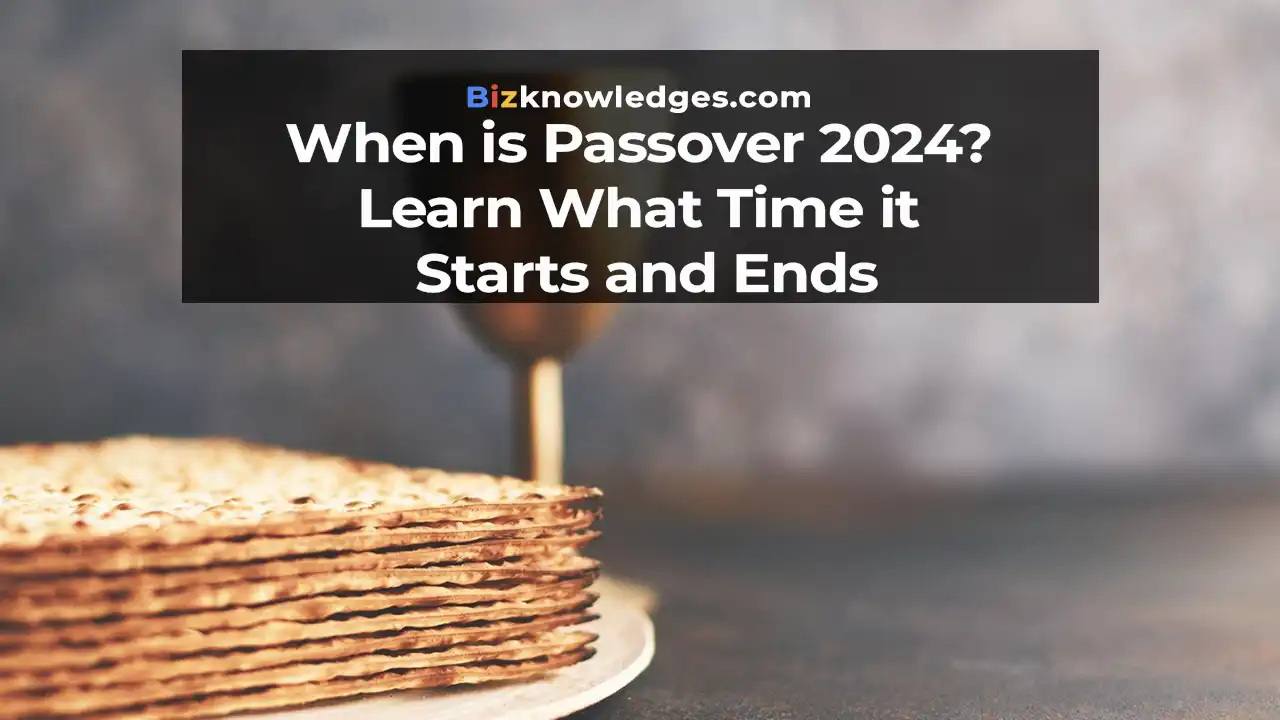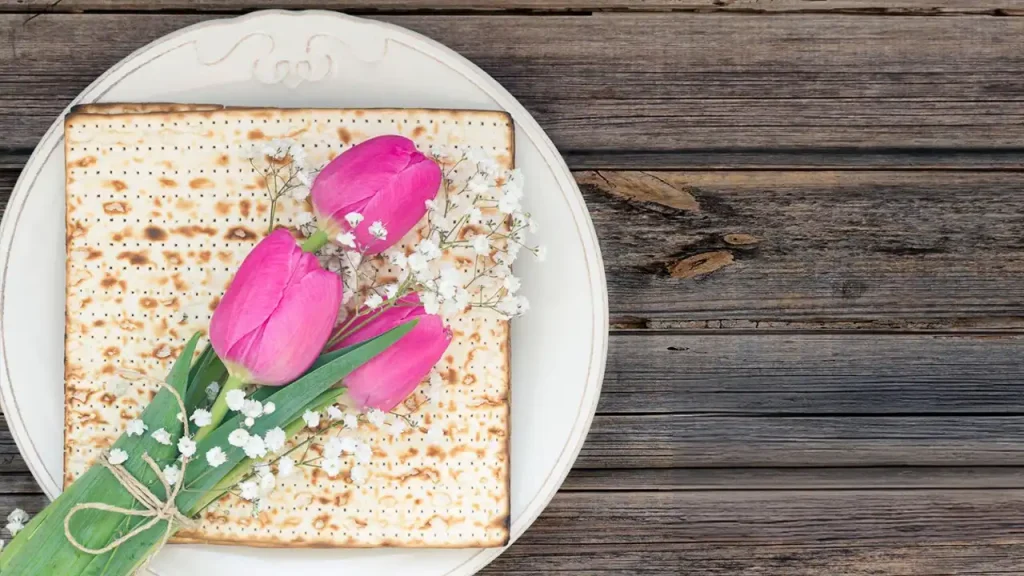When is Passover 2024? Learn What Time it Starts and Ends

When Is Passover 2024?
As the first crocuses of spring begin to push through the still-cold soil, many around the world start to prepare for Passover, one of the most sacred and widely observed Jewish holidays. Passover in 2024 will begin on the evening of Monday, April 22nd, and will end on the evening of Monday, April 29th. This eight-day festival is steeped in ancient history and rich traditions that have been passed down through generations.
Passover, or Pesach in Hebrew, commemorates the Israelites’ exodus from Egypt, which is a story of liberation fraught with plagues, miracles, and eventually, freedom. The exact dates of Passover are determined by the Hebrew calendar, which is lunar-based. Specifically, Passover begins on the 15th day of the Hebrew month of Nisan and lasts until the 22nd day in the diaspora (communities outside of Israel), and for seven days in Israel.
Every year, families and friends gather to retell this timeless story through rituals, prayers, and a festive meal known as the Seder. The Seder itself is an intricate blend of storytelling, religious observance, and culinary tradition, making Passover not just a period of remembrance, but also a vibrant celebration of freedom and community spirit.
What is Passover 2024?
Passover 2024, like every Passover, is not just a date on the calendar but a vibrant festival rich with history and meaning. It marks the celebration of the Jewish people’s liberation over 3,000 years ago from slavery in ancient Egypt, an event recounted in the Hebrew Bible in the book of Exodus. This festival resonates deeply within the Jewish community and beyond, as it embodies the universal themes of freedom, hope, and spiritual renewal.
The story that Passover commemorates is both dramatic and profound. According to the narrative, the Israelites were enslaved by the Egyptian Pharaohs for centuries. God saw their suffering and sent Moses to lead them to freedom. After Pharaoh repeatedly refused Moses’ demand to “Let my people go,” Egypt was struck with ten devastating plagues. The final plague, the death of the firstborn Egyptians, passed over the homes of the Israelites, thus giving the holiday its name. After this tragedy, Pharaoh relented, and the Israelites left Egypt in such haste they could not wait for their bread dough to rise. This is commemorated through the eating of matzah, unleavened bread.
During Passover, observant Jews avoid chametz, and the ritual of cleaning the home of these forbidden items is both a literal and symbolic preparation for the holiday. The Seder, a ritual-packed meal, features readings, songs, and symbolic foods laid out on a Seder plate. Each item on the plate has its own significance related to the theme of liberation and the story of the Exodus.
Passover is therefore a time of introspection, joy, and community gathering, celebrated amid recitations of ancient texts and the enjoyment of foods steeped in symbolic meaning. The customs associated with Passover, from the preparation of special dishes to the reading of the Haggadah, foster a sense of connection to the past and a commitment to the values of freedom and resilience.
When Is Passover in 2025, 2026, 2027, and 2028?
As we continue our journey through the calendar, marking significant moments and festivals, it’s helpful to look ahead and plan for future observances of Passover. Knowing the dates in advance can aid in preparation, whether for travel, meal planning, or organizing community events. Here’s when Passover will occur in the coming years:
- Passover 2025: Passover will start on the evening of Saturday, April 12th and will end on the evening of Saturday, April 19th.
- Passover 2026: In 2026, Passover will begin on the evening of Wednesday, April 1st and conclude on the evening of Wednesday, April 8th.
- Passover 2027: Passover will be observed from the evening of Tuesday, April 20th to the evening of Tuesday, April 27th.
- Passover 2028: The festival will commence on the evening of Sunday, April 9th and will end on the evening of Sunday, April 16th.
These dates, as always, are based on the Hebrew lunar calendar, which can lead to slight variations from year to year when compared to the Gregorian calendar. Each observance starts at sunset and lasts for either seven or eight days, depending on one’s geographic or cultural observance practices.
Understanding the timing of Passover in the coming years can help families, communities, and organizations to prepare effectively, ensuring that each Passover is a meaningful and enriching experience. Whether it’s arranging the annual Seder, coordinating with family and friends, or engaging in the deeper spiritual reflections that the holiday inspires, knowing these dates helps keep the tradition alive and vibrant in the hearts of all who celebrate.
How Long is Passover?
Passover, a festival of deep historical and spiritual significance, spans different durations depending on one’s traditions and where they are in the world. Traditionally, Passover lasts for eight days in most Jewish communities outside of Israel. In Israel and among some liberal Jewish communities around the world, Passover is celebrated for seven days.
The distinction in observance stems from ancient practices. Originally, the festival was seven days long, as instructed in the Torah. However, due to the complexities of using a lunar calendar, an additional day was added for Jews living outside of Israel to ensure they did not miss the observances due to calendar discrepancies. This practice has continued in many communities to this day, reflecting a blend of historical tradition and contemporary religious observance.
During Passover, the first and last days (first two and last two outside of Israel) are particularly significant and are observed as full-fledged holidays. Work is restricted on these days, much like on the Sabbath. The intermediate days are known as Chol HaMoed and are less strict, allowing for various forms of work but still imbued with the festive spirit.
The length of Passover not only marks a period of commemoration but also creates a structured time for reflection on themes of freedom and redemption, deepening the holiday’s impact through rituals, meals (Seders), and community gatherings. Each day provides an opportunity to engage with the holiday’s traditions and meanings, making Passover a profound experience for those who observe it.
How to Celebrate the Holiday
Celebrating Passover is both a deeply traditional and a profoundly personal experience, blending ancient rituals with contemporary relevance. Here’s a guide to embracing the holiday’s traditions, ensuring each element of Passover is both meaningful and joyous.

1. Cleaning the House of Chametz
Before Passover begins, homes are thoroughly cleaned to remove chametz (leavened bread and other leavened products). This physical cleaning is also seen as a spiritual preparation, symbolizing the removal of puffiness (pride) from our souls.
2. Preparing and Hosting a Seder
The Seder, held on the first night of Passover (and the second night in many communities outside of Israel), is the centerpiece of Passover celebrations. This ritual-packed meal involves the following key components:
- Seder Plate: A special plate containing symbolic foods including matzah (unleavened bread), maror (bitter herbs), charoset (a sweet paste representing the mortar used by the Israelites), karpas (a green vegetable, usually parsley, dipped in salt water), zeroa (a roasted bone), and an egg.
- Four Cups of Wine: Each participant drinks four cups of wine at various points in the Seder, symbolizing freedom and divine deliverance.
- Reading the Haggadah: This text tells the story of the Exodus from Egypt and is read throughout the Seder. It includes prayers, stories, and songs.
- Asking the Four Questions: Traditionally asked by the youngest person at the table, these questions begin with “Why is this night different from all other nights?” They set the stage for discussing the themes of Passover.
3. Eating Matzah
During the entire duration of Passover, matzah is eaten as a reminder of the haste with which the Israelites fled Egypt, leaving no time for their bread to rise.
4. Refraining from Chametz
Beyond removing chametz from the home, observant Jews do not consume chametz throughout the holiday. This includes bread, pasta, and most alcoholic beverages, except for kosher for Passover wine.
5. Participating in Community Services
Many attend special services at synagogues during Passover, which include readings from the Torah and special prayers celebrating freedom.
6. Engaging Children and Family
Passover is very much a family-centered holiday. Engaging children in the preparations and observances is crucial. They can help with cleaning, setting the Seder table, preparing some of the Seder foods, and practicing the Four Questions.
7. Reflecting on Freedom and Justice
Passover is an opportunity to reflect on the themes of freedom, justice, and redemption. Many people use this time to consider both personal and societal liberations needed today, making the ancient story of Exodus resonant and relevant.
The History of Passover
Passover is a festival that resonates through the ages, intertwining ancient rituals with historical significance and carrying profound spiritual meaning. Its roots go back to the biblical story of Exodus, forming a core narrative of Jewish identity and faith.
Origins in Ancient Egypt
The origin of Passover is recorded in the Book of Exodus in the Hebrew Bible. The Israelites, enslaved in Egypt for hundreds of years, were liberated under the leadership of Moses, whom God had instructed to demand their freedom from Pharaoh. Pharaoh’s heart hardened, and he refused, leading to God inflicting ten devastating plagues on Egypt. The final plague, the death of the Egyptian firstborns, led to the decree that spared the Israelites, who marked their doorposts with lamb’s blood as a sign for the plague to ‘pass over’ their homes. This event precipitated the Israelites’ hurried exodus from Egypt, so rapid that their bread did not have time to leaven, resulting in matzah, unleavened bread.
Biblical Commandments
Following the Exodus, Passover was instituted as an annual festival to commemorate this great deliverance. The Torah commands the removal of leaven from homes and the celebration of the feast with a sacrificial offering and the eating of matzah and bitter herbs. This observance was meant to remind future generations of the Israelites’ suffering in Egypt and the jubilation of their freedom.
Historical Observances
Throughout centuries, the observance of Passover evolved. During the time of the Temple in Jerusalem, Jews made pilgrimages to the Temple to offer the Paschal (Passover) lamb. Post-Temple, with the Jewish diaspora, the rituals adapted to home and synagogue practices. The Seder evolved as a way to retell the story of the Exodus, incorporating various symbols and foods to make the narrative engaging and educational, especially for children.
Modern-Day Celebrations
Today, Passover is celebrated by Jewish communities worldwide. It remains a time for families to gather and reflect on not only their shared heritage but also themes of oppression, freedom, and human dignity. The Seder, with its readings, songs, and symbolic foods, serves as a vivid reenactment of the Jewish journey from slavery to freedom, reminding participants of the enduring human desire for liberty and justice.
Cultural Impact
Beyond its religious observance, Passover has influenced various aspects of culture and thought. It has been a source of inspiration in literature, art, and music, and it has found parallels in many other cultures and belief systems that celebrate freedom and human rights.
The history of Passover is a testament to the resilience and faith of the Jewish people. It continues to be a powerful reminder of the triumph of freedom over oppression, resonating with universal themes that are as relevant today as they were over three millennia ago.
Passover Recipes
Passover is not only a time of reflection and celebration but also a festival rich in culinary traditions. The unique dietary restrictions of Passover, which exclude chametz (leavened bread and other products made from wheat, barley, rye, oats, or spelt), give rise to a distinctive array of dishes that are both delicious and symbolic. Here’s a selection of traditional Passover recipes that highlight the holiday’s flavors and themes:

1. Matzah Ball Soup
A staple at many Seders, matzah ball soup features light, fluffy matzah balls made from matzah meal, eggs, water, and oil, floating in a clear, savory chicken broth. This comforting dish is both a favorite and a symbol of warmth and nourishment.
2. Charoset
This sweet, chunky paste of fruits and nuts symbolizes the mortar the Israelites used to build the structures in Egypt as slaves. Recipes vary widely by region: Ashkenazi Jews often use apples, walnuts, and sweet wine, while Sephardic Jews might include dates, figs, and almonds.
3. Gefilte Fish
Traditionally served as an appetizer, gefilte fish is a poached mixture of ground deboned fish, typically carp, whitefish, or pike, seasoned with onions, eggs, and matzah meal. It is usually eaten with horseradish.
4. Brisket
Brisket is a popular main dish for Passover. This slow-cooked cut of beef becomes tender and flavorful, often cooked with a mix of sweet and savory ingredients like onions, carrots, and sometimes dried fruits or tomato sauce.
5. Potato Kugel
Grated potatoes, onions, and eggs, baked until crispy on the outside and soft on the inside, make potato kugel a comforting and filling side dish that complements any Passover meal.
6. Flourless Chocolate Cake
Desserts during Passover can be challenging due to the restriction against flour, but a rich, dense flourless chocolate cake, often made with ground almonds or coconut flour, provides a decadent conclusion to the meal.
7. Macaroons
Coconut macaroons, moist and chewy, are a Passover dessert staple. Made with shredded coconut, egg whites, and sugar, they come in various flavors, including chocolate-dipped, almond, and vanilla.
Conclusion
Passover is a festival that extends beyond its historical religious origins, offering rich cultural, spiritual, and culinary experiences. Each year, as Jewish families and communities around the world gather to commemorate their ancestors’ flight from Egyptian slavery, they reconnect with a story that is fundamental not only to Judaism but to the universal themes of freedom, resilience, and hope.
Through the rituals of cleaning chametz from their homes, participating in the Seder, and consuming symbolic foods, participants immerse themselves in the narrative of liberation and renewal. The traditions practiced during Passover, from the recitation of the Haggadah to the preparation of special meals, serve as a bridge between past and present, allowing each generation to appreciate the depths of their heritage and the enduring importance of freedom and human dignity.
